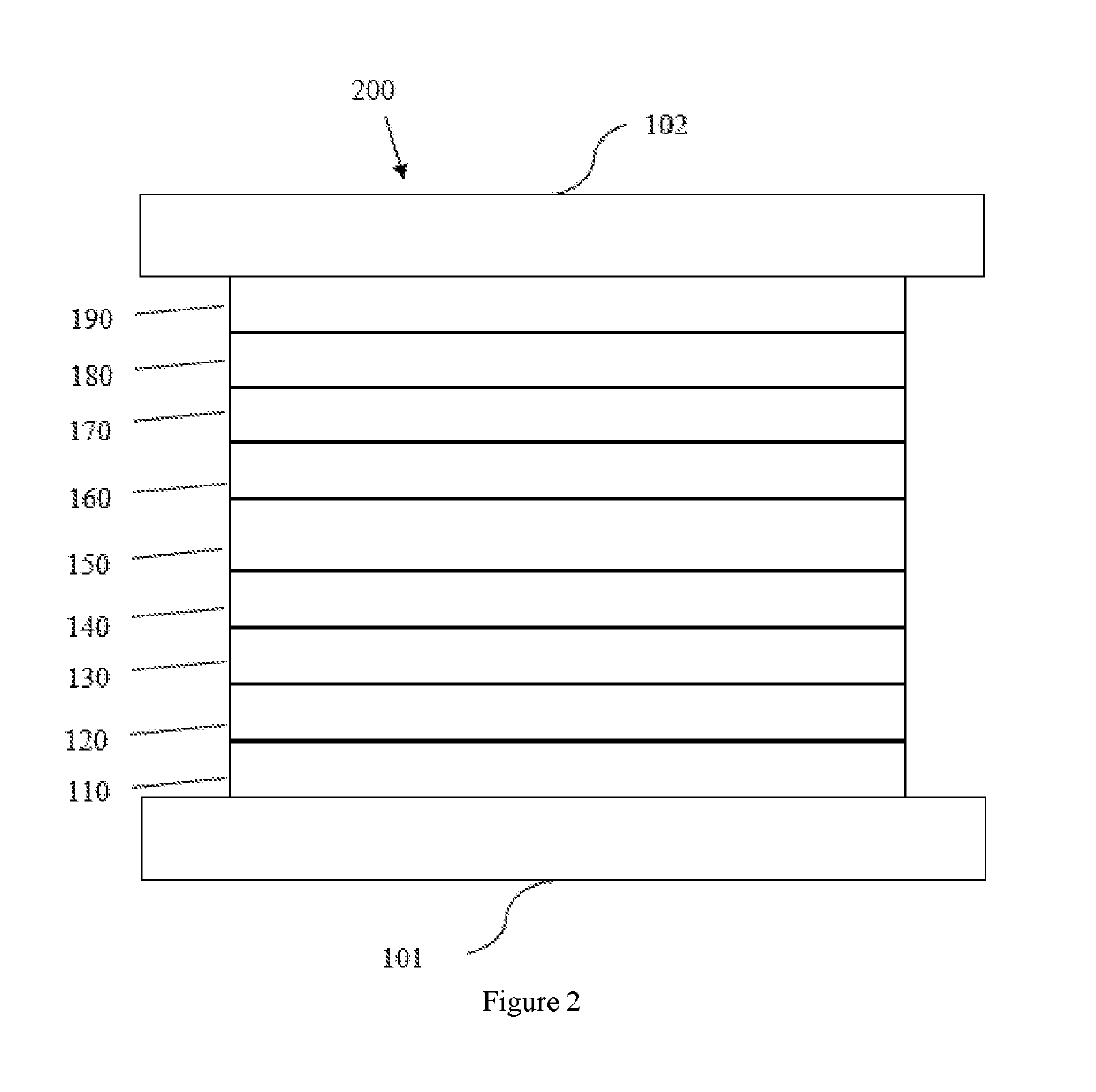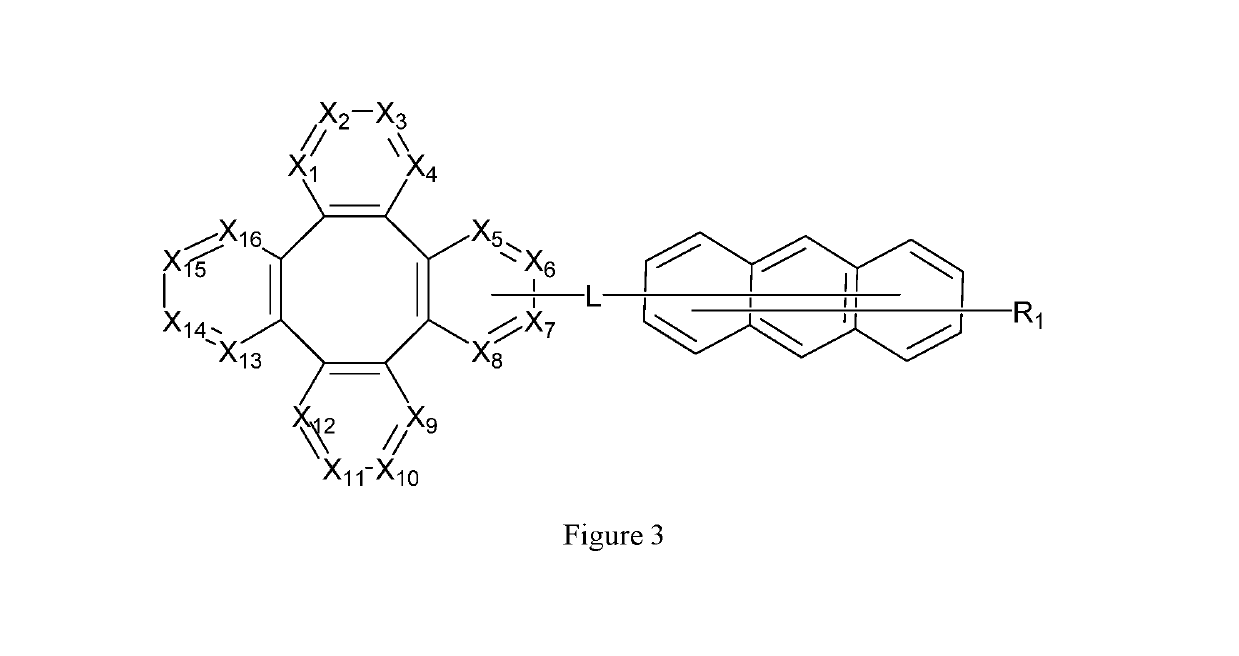Tetraphenylene anthracene compounds
a technology of tetraphenylene anthracene and compound, which is applied in the field of compounds for organic electronic devices, can solve the problems of short device lifetime, high operating voltage, and oled commercialization, and achieve the effect of improving device performan
- Summary
- Abstract
- Description
- Claims
- Application Information
AI Technical Summary
Benefits of technology
Problems solved by technology
Method used
Image
Examples
synthesis example
[0098]The method for preparing the compounds of the present invention is not limited. The following compound is exemplified as a typical but non-limiting example, and its synthesis route and preparation method are as follows:
synthesis example 1
nd 11
[0099]Step 1
[0100]9-bromoanthracene (20.0 g, 78.13 mmol), (4-(naphthalen-2-yl)phenyl)boronic acid (22.3 g, 93.15 mmol), potassium carbonate (21.5 g, 156.3 mmol) were added to a mixture of toluene (600 mL) and water (100 mL) to give a colorless suspension. Tetrakis(triphenylphosphine)palladium(0) (2.7 g, 3.9 mmol) was added to the reaction mixture, then the reaction mixture was degassed with nitrogen and heated to 110° C. for 24 hours. After the reaction was cooled down to room temperature, the product was extracted with dichloromethane. The organic phase was separated and collected. The solid was washed with dichloromethane and methanol to afford 9-(4-(naphthalen-2-yl)phenyl)anthracene (20.0 g, 67% yield) as a yellow solid.
[0101]Step 2
[0102]9-(4-(naphthalen-2-yl)phenyl)anthracene (12.0 g, 31.5 mmol), N-bromosuccinimide (4.0 g, 9.3 mmol) were dissolved in dichloromethane (500 mL), then the reaction mixture was degassed with nitrogen and heated to 35° C. for 12 hours. The mixture...
synthesis example 2
nd 13
[0105]Step 1
[0106]9-bromoanthracene (20 g, 78.13 mmol), (3-(naphthalen-2-yl)phenyl)boronic acid (22.3 g, 93.2 mmol), potassium carbonate (21.5 g, 156.3 mmol) were added to a mixture of toluene (600 mL) and water (100 mL) to give a colorless suspension. tetrakis(triphenylphosphine)palladium(0) (2.7 g, 3.9 mmol) was added to the reaction mixture, then the reaction mixture was degassed with nitrogen and heated to 110° C. for 24 hours. After the reaction was cooled down to room temperature, the product was extracted with dichloromethane. The organic phase was separated and collected. The solid was washed with dichloromethane and methanol to afford 9-(3-(naphthalen-2-yl)phenyl)anthracene (18.0 g, 60% yield) as a yellow solid.
[0107]Step 2
[0108]9-(3-(naphthalen-2-yl)phenyl)anthracene (12.0 g, 31.5 mmol), N-bromosuccinimide (4 g, 9.3 mmol) were dissolved in dichloromethane (1000 mL), then the reaction mixture was degassed with nitrogen and heated to 35° C. for 12 hours. After the react...
PUM
| Property | Measurement | Unit |
|---|---|---|
| Length | aaaaa | aaaaa |
| Volume | aaaaa | aaaaa |
| Nanoscale particle size | aaaaa | aaaaa |
Abstract
Description
Claims
Application Information
 Login to View More
Login to View More - R&D
- Intellectual Property
- Life Sciences
- Materials
- Tech Scout
- Unparalleled Data Quality
- Higher Quality Content
- 60% Fewer Hallucinations
Browse by: Latest US Patents, China's latest patents, Technical Efficacy Thesaurus, Application Domain, Technology Topic, Popular Technical Reports.
© 2025 PatSnap. All rights reserved.Legal|Privacy policy|Modern Slavery Act Transparency Statement|Sitemap|About US| Contact US: help@patsnap.com



